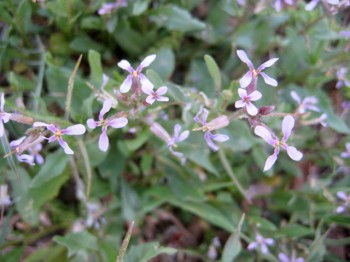
Try as I might to remember, I almost always forget my shopping bags when I go to the grocery store. I rarely forget them, however, when I go into the wild.
It’s a good thing too, because Friday’s foray among the wild former farmlands of Denver’s outskirts was a shopping trip to remember; I found so many awesome goodies with my dear friend, metro-area forager, Butterpoweredbike.
The Mile High City was bursting with plant life, the ground dappled with sunlight streaming through new foliage and flowers on the trees. “Stop. Listen. Do you hear that?” Butter asked. “It’s the sound of the wind through leaves. It wasn’t like that a couple days ago,” she mused happily as we skipped back with our afternoon forage of nettles (Urtica gracilis) and musk mustard (Chorispora tenella).
I had managed to sting my injured knee through the hole in my pants while collecting the nettles, but Butter gave me a handful of mallow (and grass) to chew up and spit onto it. After weeding the grass from the handful, I did as instructed, and it seemed to do the trick. Afterwards we were nibbling musk mustard on the side of the trail when two gents walked by and said, “Don’t eat the grass, girls! That’s for the dogs.” Tee hee.
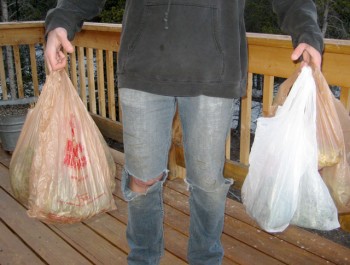
Denver Area Stuff in Season Now
When all was said and done I came home with many shopping bags of wild food, including feral garlic, thistle rosettes/crowns/roots, a few burdock roots (Arctium sp.), horehound leaves (Marrubium vulgare), stinging nettles, musk mustard, dock, and young, new cattail shoots (Typha sp.), not to mention the other stuff from her stores that she pressed into my hand.
Some of the spots we visited were once farmland, and because of that, asparagus and fruit trees exist in some places as volunteers, or cultivated plants gone wild. They can be found springing up in unlikely locations if one takes the time to look.
Some of the foods we foraged are weeds in the undesirable sense of the word. Burdock produces unwelcome, prickly balls and is a pernicious reproducer. Farmers might invite you to dig up their thistles—certain species of which are considered to be invasive—and I can think of no other person but a forager who squeals with delight upon encountering a patch of stinging nettles.
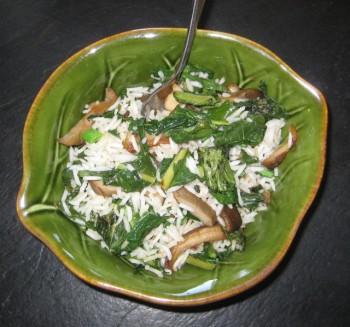
Fresh Oyster Mushrooms for Lunch
Anyway, we had fresh oyster mushrooms stir-fried with dock, dandelion greens, and the feral garlic over rice for lunch.
Butter foraged the mushrooms from a dead cottonwood stump the day prior and it’s a good thing she did because when we returned to the scene so that I could see where low-elevation oysters like to hang out, someone else had already sawed off the ones she left behind. Back at the house, she handed me Vera Stucky Evenson’s book, Mushrooms of Colorado and the Southern Rocky Mountains (1997) and made me confirm her identification, even though she herself was confident with it already.
This double/independent verification is good strategy, especially considering the case of author Nicholas Evans, who served foraged mushrooms to a party of family members after he and his brother-in-law mistakenly put their faith in each other’s uninformed decision to eat them and ended up consuming poisonous Cortinarius speciosissimus (deadly webcap) instead of the intended Boletus edulis (ceps). This resulted in kidney failure for Evans, his wife Charlotte, and brother–in-law Sir Alastair Gordon-Cumming.
It is not impossible to eat wild mushrooms safely, but neither is ‘To eat or not to eat’ a decision to take lightly. My PR professor used to say, “When in doubt, throw it out,” and although he was referring to that type of writing known as “spin,” the dictum is applicable to wild mushrooms as well, especially when one lacks expertise with fungi or the willingness to consult reliable ID guides.
Butter’s oysters did fit the profile for Pleurotus pulmonarius, a mushroom I’d never before eaten, though I have dined on its high elevation cousin, Pleurotus populinus. The low elevation species is supposedly tougher, but the consistency was excellent nonetheless.
Folks seem a bit incredulous that it is wild mushroom season already, but my tummy can attest to it—at least insofar as lower elevation locations are concerned. Some words of advice for the would-be mycophagist: 1. Look for mushrooms after it rains; 2. Be absolutely certain of your identification; and 3. Try not to eat Butter’s oysters.
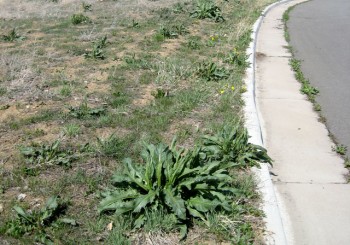
Denver Dock
Denver dock is everywhere. I saw it growing in clumps amidst the grass on nearly every highway median that met my eye. What a tragedy to see so much good food growing by the roadside, since wild organic veggies are better when they’re not coated in automobile exhaust. I guess, at that point, they are no longer organic.
Fortunately, there are less trafficked spots hidden throughout the city, so we were able to access a dock-spotted field from an isolated roadway. “Take a lot,” Butter said, as her Denver docks are reaching the end of their spring season, during which time the basal leaves of young spring docks are clean of bugs and not yet tough or bitter.
In contrast, my dock patch at 10,000 feet has barely seen the light of day, having only recently emerged from under the spring snow melt.
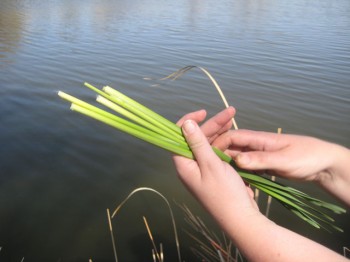
While we were collecting the young, stretchy leaves, up pulled a car driven by a man in a business suit with an elderly woman in the passenger seat. She smiled at me and rolled down the window to ask what we were collecting. “Dock!” I replied enthusiastically. “Would you like some?”
In the end the duo drove away with a small bag of dock and some hastily delivered preparation instructions, including to cook the stuff. “Now we know where to get it,” the man enthused. “And it’s probably healthy too!”
Peas Are an Unusual Find
Back at Butter’s house, looking for something with which to ice my knee in preparation for the long journey home, she came up with a bag of frozen peas. Frozen peas, eh? Now that’s an unusual find for such a fanatical forager’s freezer. They must be “volunteers.”
Updated 2.18.21

Yeah! love that mustard! We always smell it long before we see it… great post erica
when you say “wild garlic” are you referring to one of our feral alliums, or do you mean garlic mustard (alliaria)?
@ rico & beth: Yeah I’m totally psyched about the musk mustard. Hadn’t tried it before this trip. Since then I’ve eaten it as a green on sandwiches and in an omelet with the oysters.
As for the “wild garlic” question, well, that is the mystery of the day. It’s an Allium but as to what one, I don’t know. That’s why I was vague and used quotation marks around “wild garlic” in the post. I believe we have both feral & native Alliums around, no? If so, I don’t know if this is a feral plant or not. Butter just found it through a fellow forager and we are trying to figure out what it is. Looks like a leek to me but it wasn’t yet flowering so it’s hard to tell. If you have any thoughts on it, please share! And thanks for the kind words:)
about th’ mustard- glad you found it, another one of those treasures hiding right under our noses… have you tasted just th’ flowers yet? we like to separate them from th’ greens for another completely unique flavor…
about th’ garlic- as far as we know there’s so many subspecies of them around here it’ll make your head spin- i don’t worry too much about th’ names for this plant, usually just differentiating between th’ garlic and onions, both of which abound- anyway, our most common, here in ft. collins, looks like th’ ones in this post here,… http://survivalinthewasteland.blogspot.com/2011/10/on-our-family-tree-our-ancestors-are-th.html, they’re about halfway down in th’ post, did yours look like that? It may be hard to tell from th’ pics, but th’ clove is single, not bulbous like other garlics… small white flowers in clusters of about 20-100, late summer, distinctive garlic smell, and when cleaned th’ whole plant is delicious, of course to be harvested with all th’ respect due to a root crop, leave enough for th’ colony to continue…. have you found wild horseradish left, it’s all over here, and i bet near where you live as well… sorry for th’ long comment, couldn’t find an email address for ya, back atcha
Wild horseradish, no… Sounds like I need to go on a Ft. Collins foraging adventure sometime soon. I live at 11,000 feet, so some stuff just does not abound. Checked out your pic…yes, it’s similar to what we found. I’ll have to try the musk mustard flowers separately just as soon as I get down low again. Cheers!
Yep, probably no horseradish that high, though i’d keep lookin anyway- but it’s definitely in the denver/boulder area… just wrote a post about it,
http://www.survivalinthewasteland.blogspot.com/2012/04/wild-horseradish-and-sacrifice.html
let us know if you’re ever in the area… adios
Good stuff, will do, not for a couple weeks. Cheers!